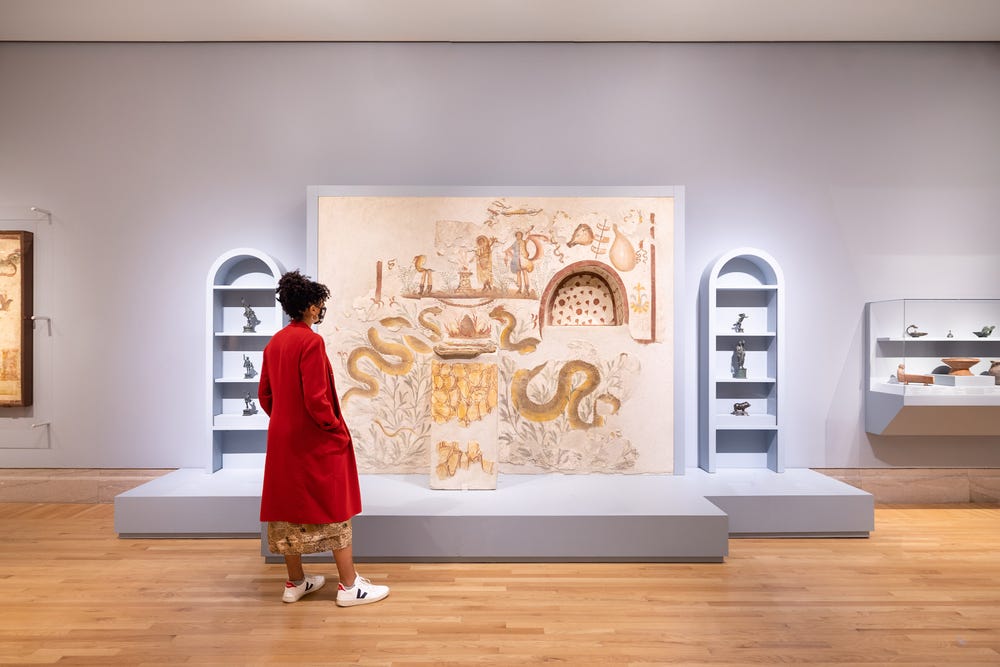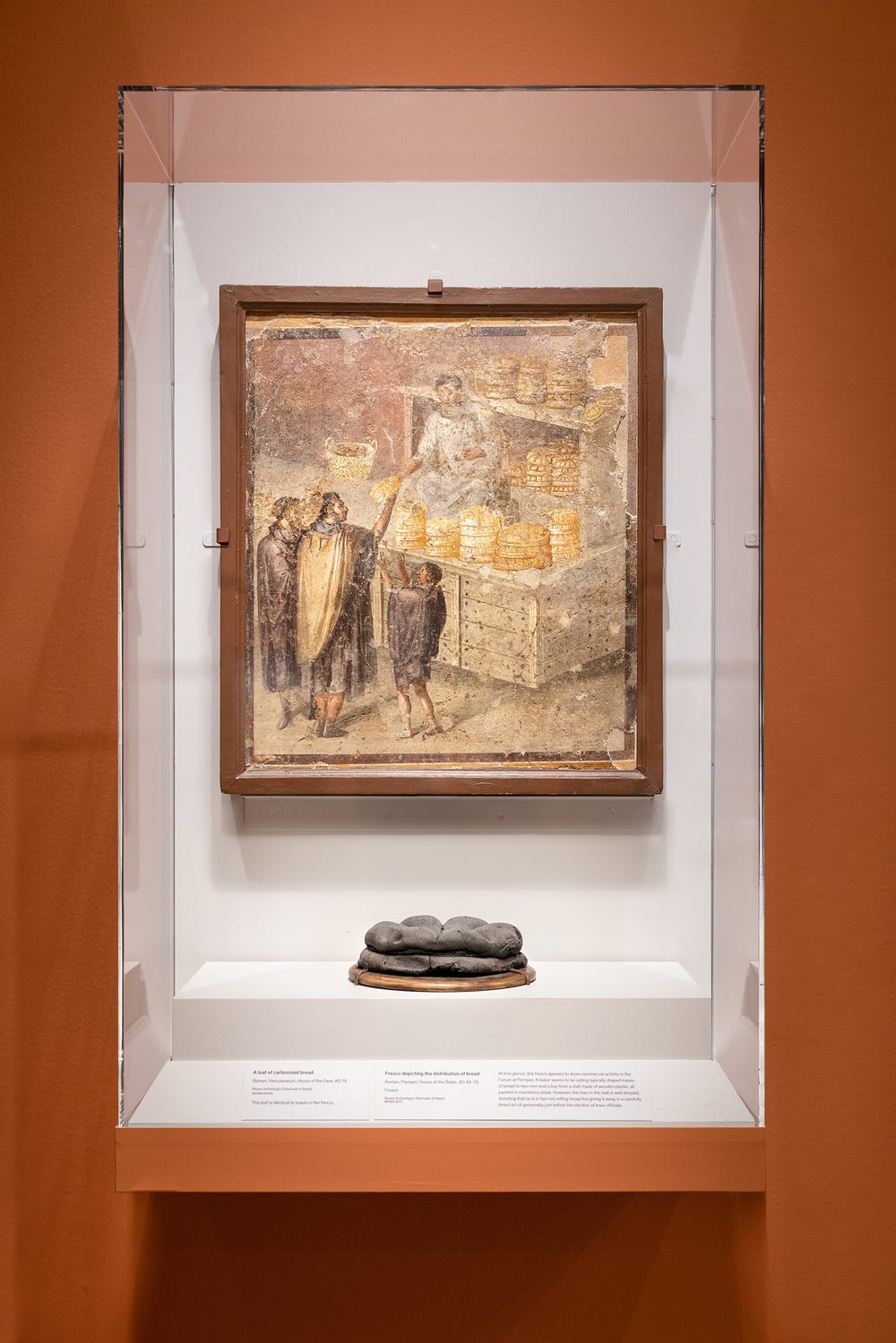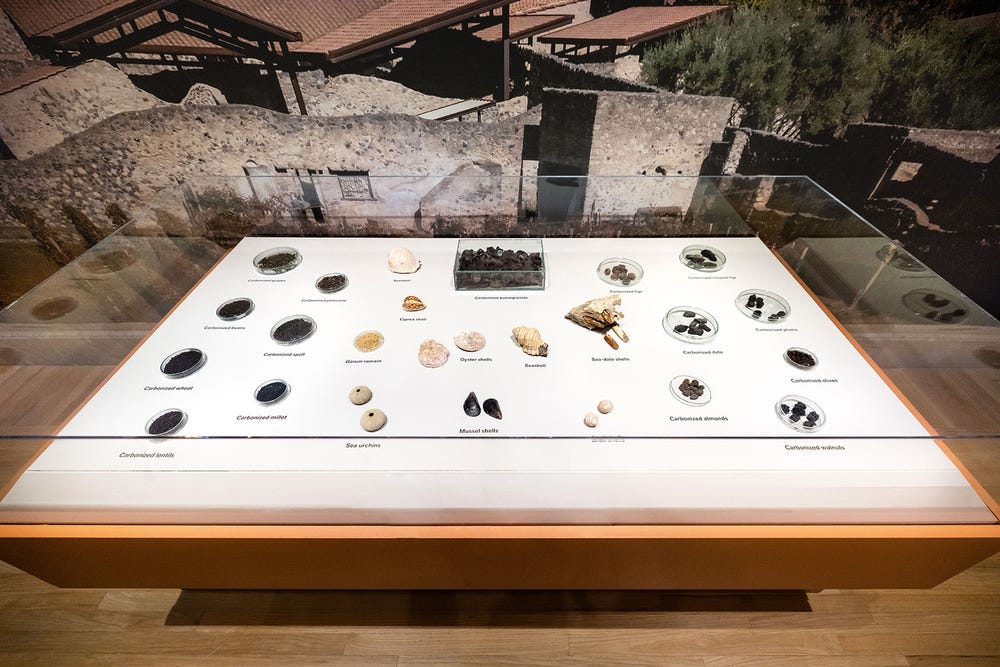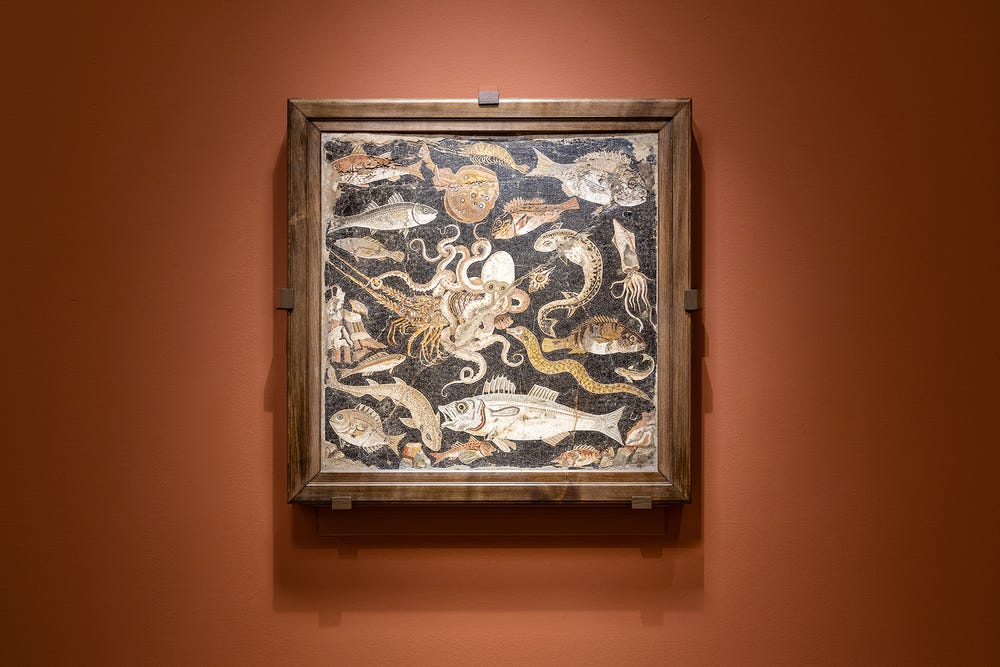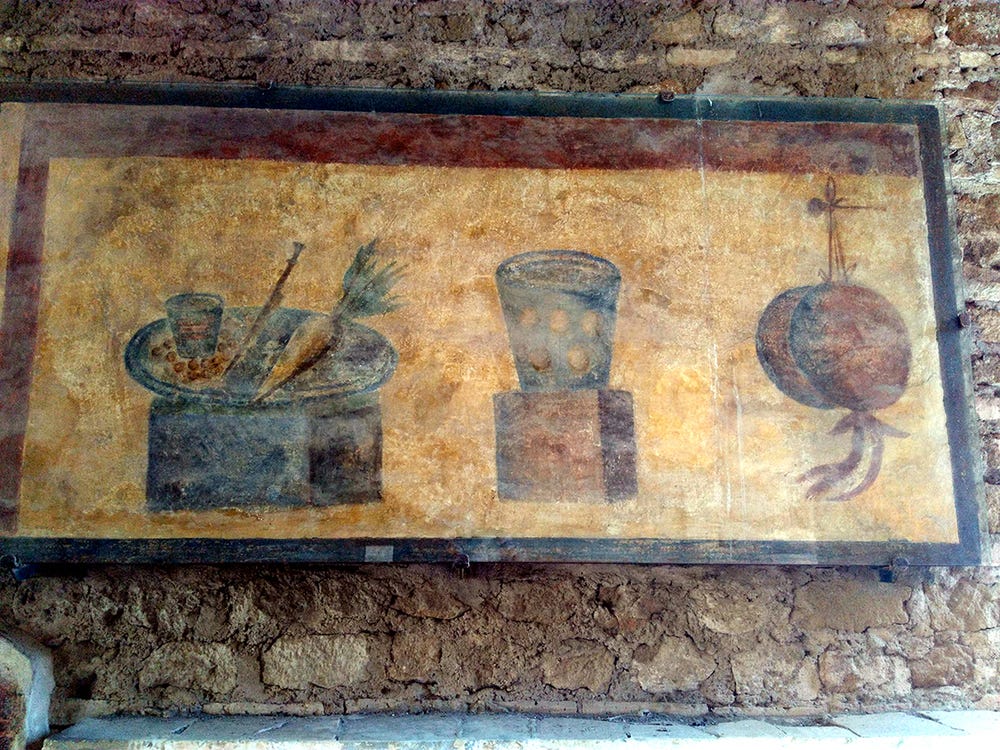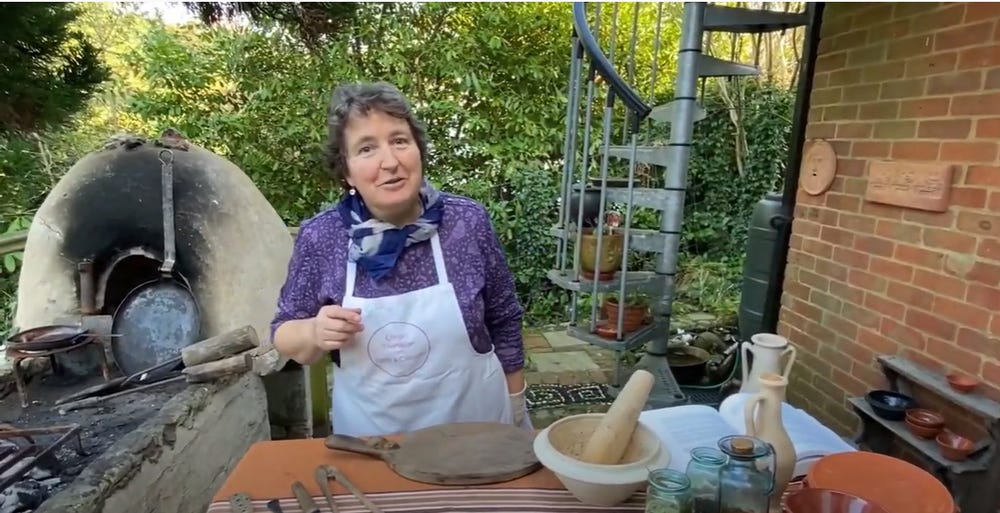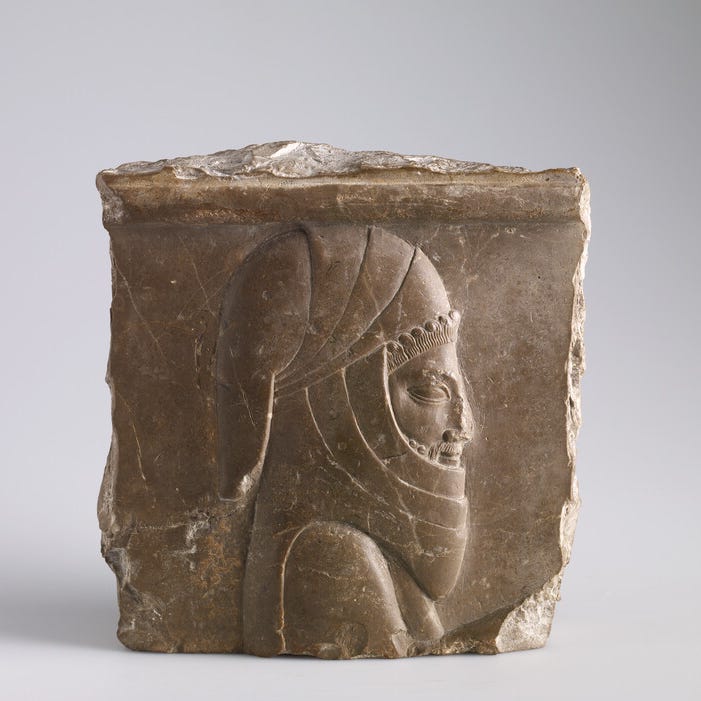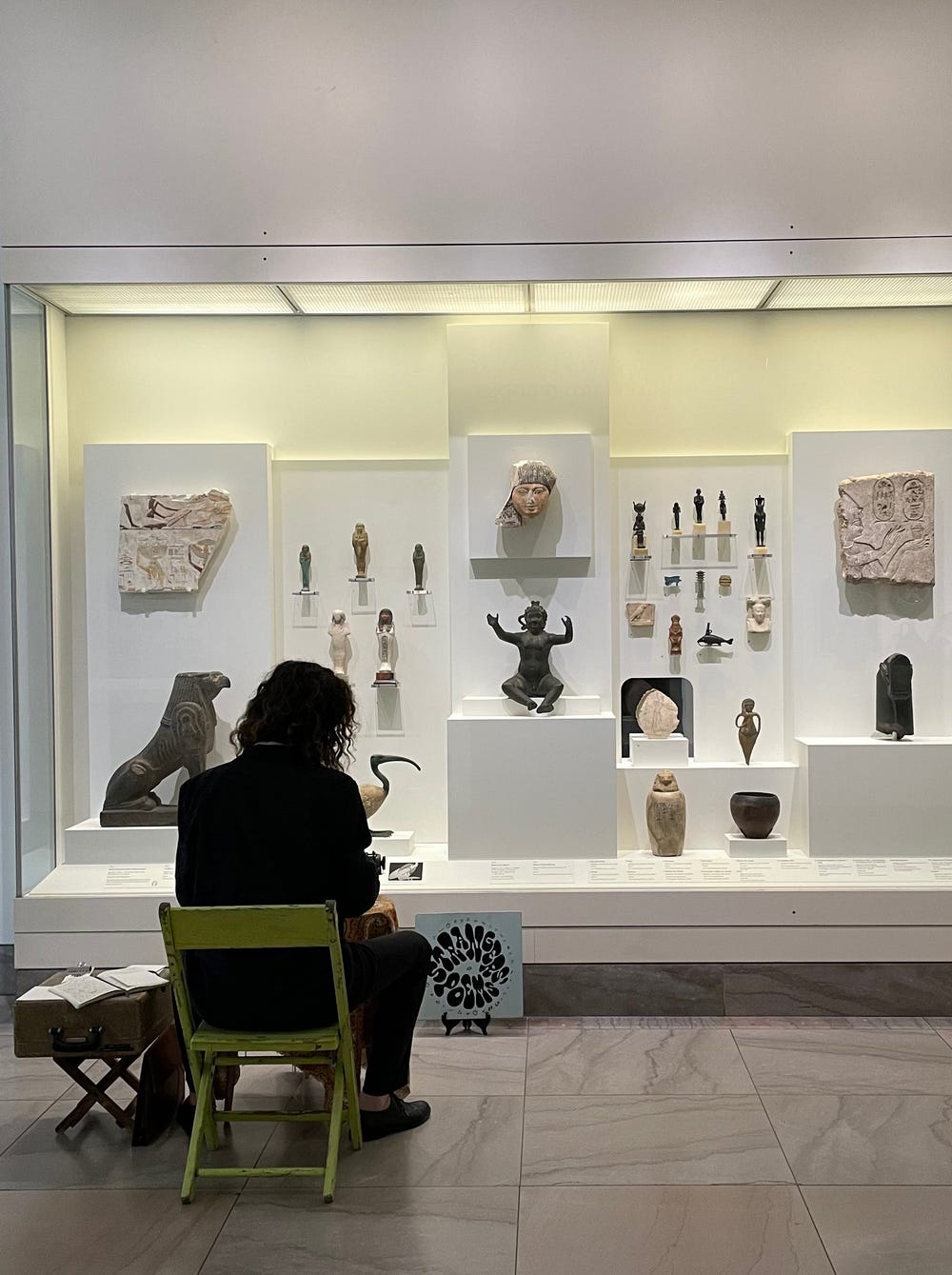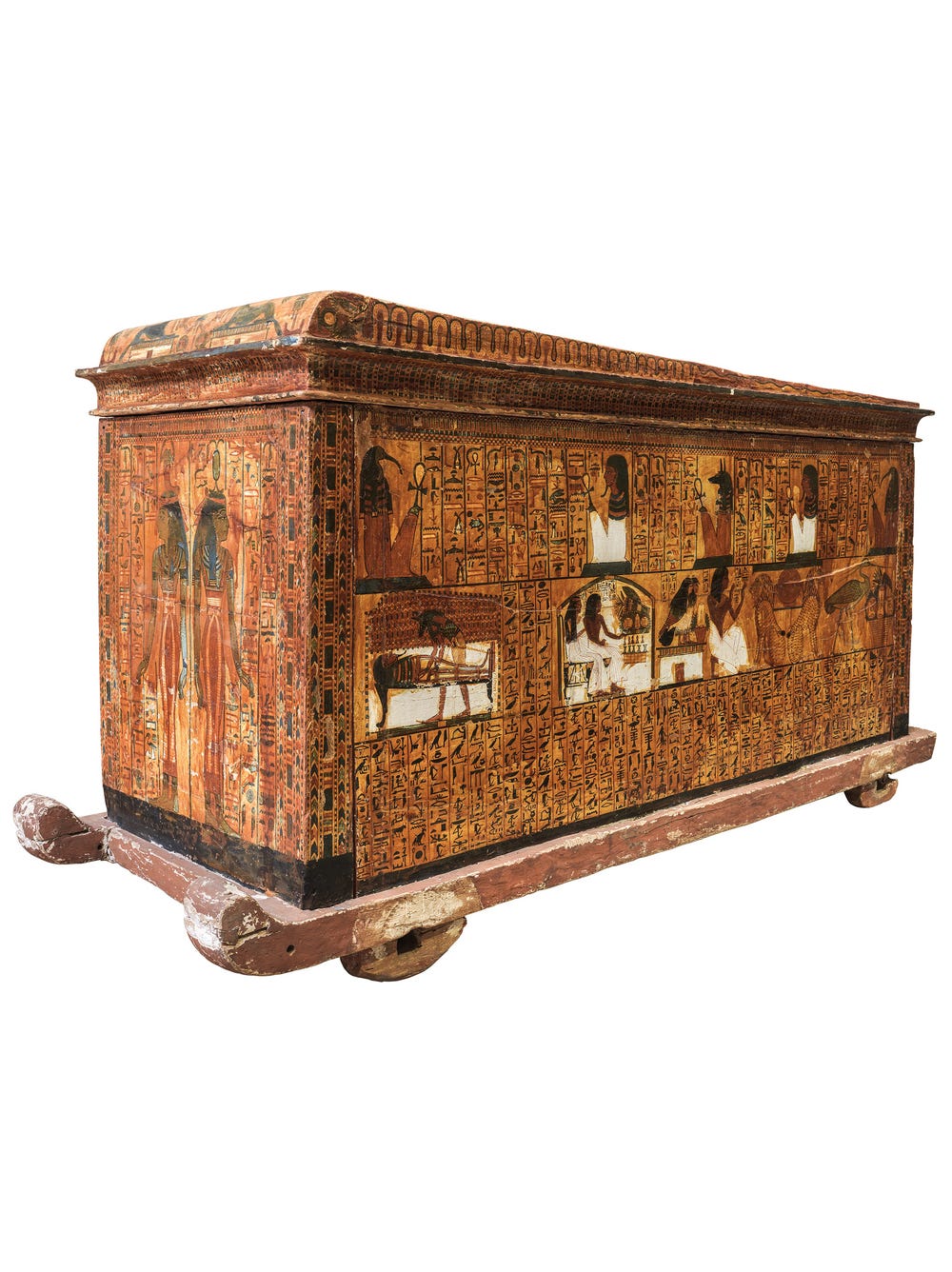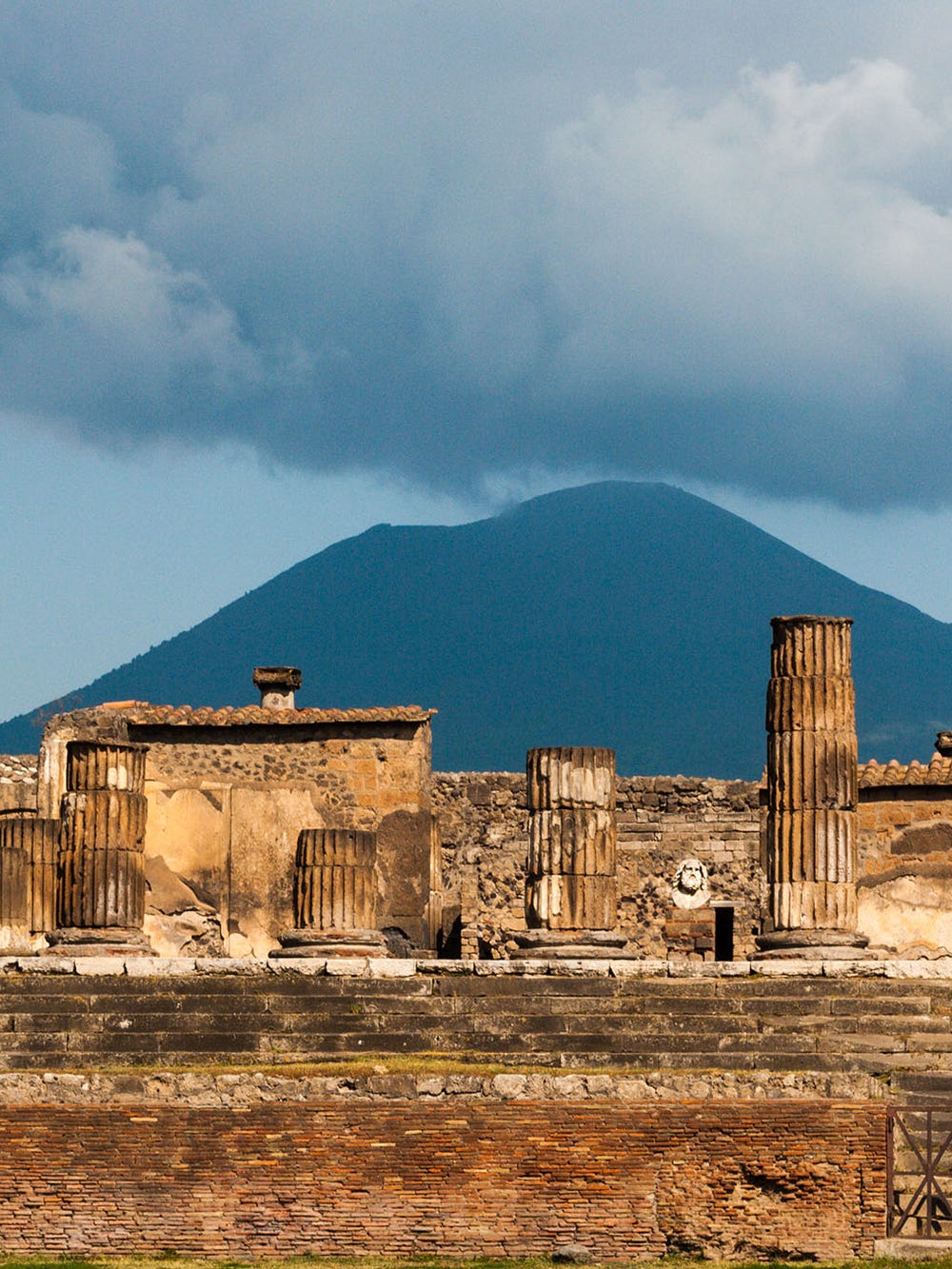The bustling city of Pompeii was halted in its tracks in the autumn of 79 AD when Mount Vesuvius erupted, crushing the city under tons of ash and rubble. The city was preserved in a snapshot of daily activities that we would never normally be able to see on an archaeological site, where structures come to their natural end. Pompeii ended very unnaturally.
The archaeology presents us with real people of all classes and social status in the process of engaging with their culinary world: purchasing food, baking bread, preparing their evening meal, socializing in the street with their purchases in hand, nibbling snacks at the baths, and reclining on a couch while slaves offer fresh oysters and fish sauce. The miraculous evidence of this process in action is displayed in this wonderful exhibition at the Legion of Honor.
Last Supper in Pompeii: From the Table to the Grave installation at the Legion of Honor. Photography by Gary Sexton
When you consider ancient Roman food, what springs to mind? The odd and the bizarre, such as dormice, and lark’s tongue, and that stinky rotten fish sauce—actually it’s not stinky or rotten. Ideas of greed and gluttony encapsulated by the entirely fictitious “vomitoria'' always come up in conversations about roman food. (“Vomitoria’ were the passageways between seats at amphitheatres that allowed the audience to exit quickly.) Were we to be transported back to the years prior to the day Pompeii was destroyed by the volcano, we would see that the reality of the Roman culinary experience, as reflected in the vast amount of evidence that survives in Pompeii, was a great deal more ordinary than we have been led to believe, but also considerably more appealing and desirable. There is much that seems alien about the Roman world, but in terms of its food it is not so strange, as you shall see.
For many years, historians believed that Roman society was divided into relatively small numbers of elites dining with excessive gluttony, while teeming millions of ordinary Romans subsisted on an enforced vegetarian diet because all meat was appropriated by the elites. This polarized image has been replaced, largely because of the kind of evidence we see in Pompeii, with a far more complex picture.
We now understand that Roman society was considerably diverse and varied in structure, with multiple layers of status in different contexts and immense mobility between the layers. The binary approach always left the middle as a blur. The middle of Roman society was largely dominated by those of “freed” ancestry. Slavery was institutional but provided a constant flow of new citizens as many were able to purchase or acquire their freedom within their own lifetime. The freedman often had the benefit of having acquired skills as a slave that he could use to earn a living, and his sons and daughters were full Roman citizens, and they were often relatively financially stable.
There were many well-off families headed by a former slave who once served in a wealthy household, now living a comfortable life and dining on foods once thought to be out of their reach. Foods that were once thought to be elite and luxury are now understood to be far more widely consumed than previously believed. Pepper was seen as the height of luxury, but in Pompeii the occasional discovery of pepper in modest homes demonstrates that ordinary citizens had access to this spice and many others.
For the vast majority of Roman citizens, their diet was varied and largely consisted of mixed Mediterranean diet which included salted and fresh quadruped meat (beef, lamb, and pork), principally from sacrificial sources; fresh and salted fish and fish sauces; pulses such as lentils and chickpeas; vegetables, dominated by brassicas and allium (cabbage, leeks, onions, and garlic). Fresh fruits were common: plums, apples, dates and figs, and also wild nuts.
The olive and the grape provided the two lubricants of Roman society. Olive oil was the main cooking oil, and Romans also used it to clean their skin, while wine was readily available to many, even the poorest citizens. Oil, wine, and fish sauce were fundamental to Roman cuisine, and they were traded in amphorae across the Mediterranean from Spain and Africa. You will see amphorae with pointed bottoms in the exhibition—they were designed specifically to accommodate these liquids. The triad of oil, wine, and fish sauce was used to create simple dressings that were ubiquitous at any Roman meal. Galen, a Greek doctor writing in the second century, suggests that even the most destitute of Romans were able to mix oil, vinegar, or wine and fish sauce together to pour over their vegetables. These mixtures were similar to vinaigrette as they were used to dress salads and vegetables but they were also used as a dip and poured over cooked food. (A recipe for a Roman vinaigrette appears at the end of this article.)
Carbonized bread and a fresco from Pompeii on view in Last Supper in Pompeii: From the Table to the Grave at the Legion of Honor. Photography by Gary Sexton
Bread was a staple for everyone, but there were different types of bread available. There is a carbonized whole-meal loaf of bread (above) taken, along with fifty or more others, from an oven that must have been filled with loaves of dough before the eruption and never opened again until archaeologists broke the seal on the oven door in the mid-nineteenth century. Bread is also central to the wall fresco depicting a candidate running for election giving away fresh bread to the well-to-do electorate in exchange for their vote. The two loaves of bread are similar in shape, but the bread used as a bribe was undoubtedly made with finer white flour.
Many carbonized seeds and fruits have been found in Pompeii, such as figs, plums, dates, olives, walnuts, and almonds. Lentils and beans are there too and were undoubtedly made into soups and stews, perhaps with a piece of bacon for flavor. These preserved foods depict plain, everyday fare that everyone consumed at some point in the day. The main meal of the day was the cena, which occurred towards the end of the afternoon after the worst of the heat. Earlier meals such as the ientaculum breakfast and prandium kind of lunch tended to be created from foods such as bread with cheese spreads or sausage. Even the ancient Romans didn’t seem to enjoy eating a large meal in the midday heat.
Display of food samples on view in Last Supper in Pompeii: From the Table to the Grave at the Legion of Honor. Photography by Gary Sexton
There is plenty of evidence of luxury delicacies too, such as sea urchins and dormice. A special dormouse pot known as a glirarium is on display in the exhibition. When you purchased a dormouse for the table, you almost certainly took it home in one of these pots. The pots’ walls are studded with air holes, and on the inside there is a narrow ledge that spirals around the interior, sort of like a narrow shelf, possibly providing the mouse a little exercise while it was fattened with fruits and nuts for the table. Dormice voluntarily eat to excess, like geese and ducks, before hibernation and this was encouraged to sweeten the meat.
We have frescos depicting fresh foods such as game and fish, which represent the kind of protein that very wealthy people preferred to consume. We can see a fresco of a couple of slaves butchering a fawn for an alfresco meal, as well as a stupendous seascape mosaic with bream bass and lobster in beautiful lifelike color (below). The best offal—liver kidney, sweetbreads, brains, gonads—were considered highly desirable at elite banquets. We have clear evidence that in the urban environment the majority of offal was reserved for elite dining, where serving numerous kidneys or making a custard out of sweetbreads and brains would have been the height of luxury. Not necessarily to our taste today, I will admit, but as these forms of offal were rare—one or two items per beast—they were inherently desirable.
Marine mosaic from Pompeii in Last Supper in Pompeii: From the Table to the Grave installation at the Legion of Honor. Photography by Gary Sexton.
For middle and lower-rank town dwellers, access to meat was more complex, as consumers had to rely on supplies donated for sacrifice to the temple precinct and thereafter available at the meat market. The wealthier middle ranks almost certainly appropriated the best cuts of beef pork and lamb, while the lowest ranks probably relied more on salted and processed meats such as sausages, salted pork, and isicia—a kind of mince made with cheap pounded meat hacked off the carcass—and some forms of lesser offal.
The Roman style of formal dining is to recline while eating on special couches constructed of wood or masonry. The household slaves brought food to the central table, and guests were expected to take food with their fingers. This social structure is depicted in a fresco where the guests are seen as full size while the slaves appear to be children within the image. The tableware of the wealthy is illustrated by silver and bronze dishes and platters as well as fine glass jugs. The more common tableware was the red terra sigilata, which comes in a huge array of shapes and sizes of bowl, platter, and dish. These types of ceramics were found in all kinds of contexts, while many were inscribed with the owner’s name and reflect a valued possession.
The diet of the town dweller of the lower ranks is difficult to determine, because their living structures haven’t survived. They often lived in apartment blocks consisting of single rooms with multiple occupants. These blocks were part of larger insula made up of a few elite town houses, shops, and industrial workshops all made of masonry with wooden apartments above. A shared community spirit may have developed in some of these insulae. Few apartment dwellers would have had access to cooking facilities in their rooms, and thus they had to either use shared cooking facilities at ground level or eat out. There are a number of small cooking braziers in the exhibition that seem unsuited to commercial cooking and may have been domestic cooktops shared among neighbors. For those without access to a cooking fire the only option would seem to be street food. This scenario has led to the common theory that street food was potentially invented by the Romans and fundamental to feeding the majority of working people. Whether this is in fact true is hard to judge. It is true that on every street in Pompeii there were numerous bars and shops that seemed to sell hot food. Many of the bars do have braziers, structures clearly used to heat coals or wood and cook food. That hot sizzling meat was served at these bars is very clear from a passage about the life of the emperor Claudius by Suetonius, where while in Rome he is said to have left the court where he was presiding, attracted by the smell of roasting meat in a local bar!
Most of these bars and shops have big jars with wooden lids buried in the counter of the shop. Every shop seems to have these structures, and it is very hard to understand what they were used for. I suspect that each shop or bar owner would have had a slightly different purpose for these jars. The heat of the Mediterranean may have destroyed the quality of fresh vegetables and meat very quickly, and these vessels may have simply been a deep, hollow cool place to store foods of all kinds. We had little in the way of residues that might tell us what kind of food was served until a very recent find in Pompeii of a bar with detailed paintings of the food on offer: a duck, chicken, and, sadly, a dog were painted on the frescoes, which might imply that canine meat was consumed. In addition, numerous bones from ducks and lamb were found inside the dolia, indicating a complex meal.
Wall painting from Ostia depicting a Roman meal. Image from Wikimedia Commons
A piece of evidence not from Pompeii but from Ostia—the port of Rome—includes a wall painting of a meal that was served to customers (above). It includes two kebab sticks with meat chunks, a layer of what seems to be pulses (lentils or chickpeas), a carrot or radish, and a small dish that may have held a sauce. The image also includes wine and bread. It represents a simple day-to-day meal for a middle-rank laborer.
A unique recipe book has survived written in Latin by slave cooks. It contains some recipes that may have been cooked in the mid to late first-century AD during the years before the destruction of Pompeii. It is called Apicius, after the famous Roman gourmet Marcus Gavius Apicius. In the collection, a number of recipes lend themselves to street food: isicia omentata was a pounded meat paste seasoned with pepper and myrtle berries and wrapped in caul fat (sausage skin in a sheet rather than a tube) before being barbecued. We can quite easily imagine this looking something like a meatball or a burger and, if served inside bread, it does seem to have taken the beef burger back into the past. It’s a difficult line to take as it is too easy to assume that the burger was Roman; we should say it was “very similar.” This meat dish was served with an oenogarum, a dipping dressing. Here is the recipe for you to try!
Beef or lamb rissole: Apicius 2.1.7
We might claim that these meat rissoles are the closest thing to a burger in the Roman recipes. The meat of choice is pounded in a mortar with a pestle until it is a smooth paste or a pâté is formed. This takes considerable time and effort (with today’s kitchen appliances the task could be accomplished in a few minutes). Once the pounded meat has been shaped into balls, they can be oven-baked, grilled, or even barbecued, as the original recipe suggests. The flavor of the myrtle berries is rather interesting—it is somewhat flowery and unexpected. If myrtle berries are unavailable, juniper berries serve as a suitable alternative. Caul fat is the membrane that holds the intestines together in the intestinal cavity in all animals; pig’s caul is generally the one most readily available. You will find caul fat at any butcher shop that makes its own sausages, especially if they make their own meatballs.
Makes TK isicia (rissole) - Serves six as a starter, four as a main course
- 1/2 lb beef or lamb mince
- 1 cup fresh bread crumbs
- 2 tablespoons white wine
- 1 tablespoon fish sauce
- 2 heaping teaspoons whole peppercorns
- Scant ¼ cup pine nuts
- 5 myrtle berries or 3 juniper berries
- 2 ounces caul fat (make sure it has been cleaned)
In a food processor, combine the meat, bread crumbs, wine, and fish sauce and process until the mixture has the texture of a smooth paste and the mince has lost its structure. In a pestle and mortar, grind the myrtle berries or juniper into a fine powder and add along with the peppercorns and pine nuts. Add the peppercorns and pine nuts and pulse briefly to combine them evenly. Transfer the mixture to a bowl. Open up each individual piece of caul fat to its full extent. Take a lump of the meat mixture and form it into a small ball about the size of an egg. Lay the ball on the edge of a sheet of fat and cut a circle around it about twice as big as the ball. Pick up the ball with the circle of fat and pull and stretch the fat to cover the ball. Place the ball on the work surface and flatten it out. Repeat with the remaining meat mixture, and be sure that the minimum amount of fat needed to cover each ball is used. Do not fold too much fat over the ball; cut it off instead. Grill, roast in a hot oven, or barbecue the balls until they are well done—brown and crisp. Serve with a sweet wine oenogarum. You can also make them smaller and serve them on cocktail skewers as party food.
Oenogarum dressings
- 1 part Red Boat fish sauce
- 1 part white wine
- 1 part olive oil
- 1 part sweet wine
- Freshly ground black pepper, a heaping teaspoon of each fresh herb (parsley, coriander, mint, thyme)
In a bowl, whisk together all the ingredients. Transfer the dressing to an airtight container and store in the fridge, it will keep for a week. Serve at room temperature. Before using, shake or whisk the sauce. Dip the isica (rissole) in the sauce.
Text and recipes by Sally Grainger. Grainger is a Roman-food historian and experimental archaeologist. She specializes in ancient fish sauce and the dining practices associated with its consumption.
Learn more about Last Supper in Pompeii, on view at the Legion of Honor May 7 through August 29, 2021.
